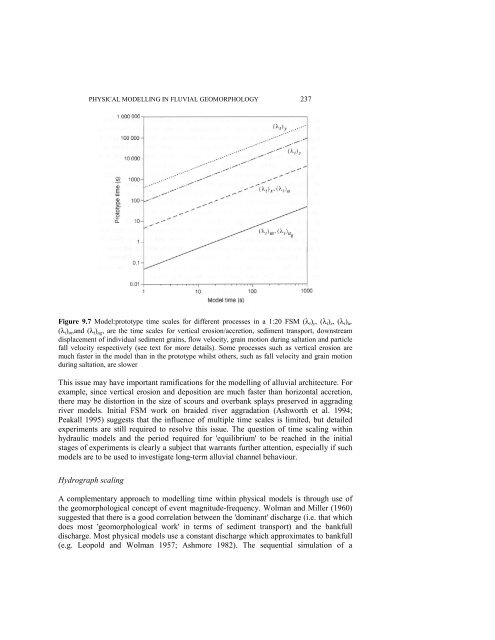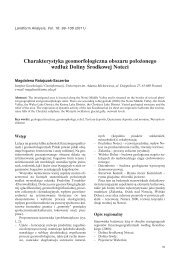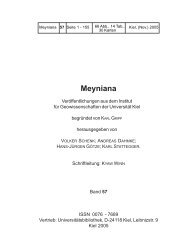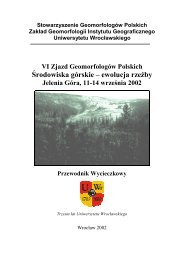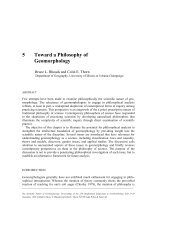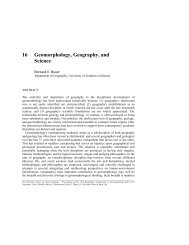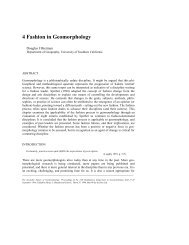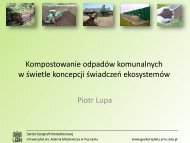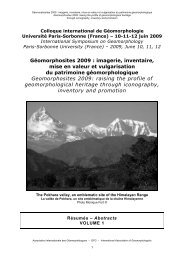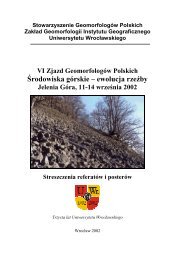Physical Modelling in Fluvial Geomorphology
Physical Modelling in Fluvial Geomorphology
Physical Modelling in Fluvial Geomorphology
You also want an ePaper? Increase the reach of your titles
YUMPU automatically turns print PDFs into web optimized ePapers that Google loves.
PHYSICAL MODELLING IN FLUVIAL GEOMORPHOLOGY 237<br />
Figure 9.7 Model:prototype time scales for different processes <strong>in</strong> a 1:20 FSM (λ t) y, (λ t) s, (λ t)u,<br />
(λ t) m,and (λt) ug, are the time scales for vertical erosion/accretion, sediment transport, downstream<br />
displacement of <strong>in</strong>dividual sediment gra<strong>in</strong>s, flow velocity, gra<strong>in</strong> motion dur<strong>in</strong>g saltation and particle<br />
fall velocity respectively (see text for more details). Some processes such as vertical erosion are<br />
much faster <strong>in</strong> the model than <strong>in</strong> the prototype whilst others, such as fall velocity and gra<strong>in</strong> motion<br />
dur<strong>in</strong>g saltation, are slower<br />
This issue may have important ramifications for the modell<strong>in</strong>g of alluvial architecture. For<br />
example, s<strong>in</strong>ce vertical erosion and deposition are much faster than horizontal accretion,<br />
there may be distortion <strong>in</strong> the size of scours and overbank splays preserved <strong>in</strong> aggrad<strong>in</strong>g<br />
river models. Initial FSM work on braided river aggradation (Ashworth et al. 1994;<br />
Peakall 1995) suggests that the <strong>in</strong>fluence of multiple time scales is limited, but detailed<br />
experiments are still required to resolve this issue. The question of time scal<strong>in</strong>g with<strong>in</strong><br />
hydraulic models and the period required for 'equilibrium' to be reached <strong>in</strong> the <strong>in</strong>itial<br />
stages of experiments is clearly a subject that warrants further attention, especially if such<br />
models are to be used to <strong>in</strong>vestigate long-term alluvial channel behaviour.<br />
Hydrograph scal<strong>in</strong>g<br />
A complementary approach to modell<strong>in</strong>g time with<strong>in</strong> physical models is through use of<br />
the geomorphological concept of event magnitude-frequency. Wolman and Miller (1960)<br />
suggested that there is a good correlation between the 'dom<strong>in</strong>ant' discharge (i.e. that which<br />
does most 'geomorphological work' <strong>in</strong> terms of sediment transport) and the bankfull<br />
discharge. Most physical models use a constant discharge which approximates to bankfull<br />
(e.g. Leopold and Wolman 1957; Ashmore 1982). The sequential simulation of a


